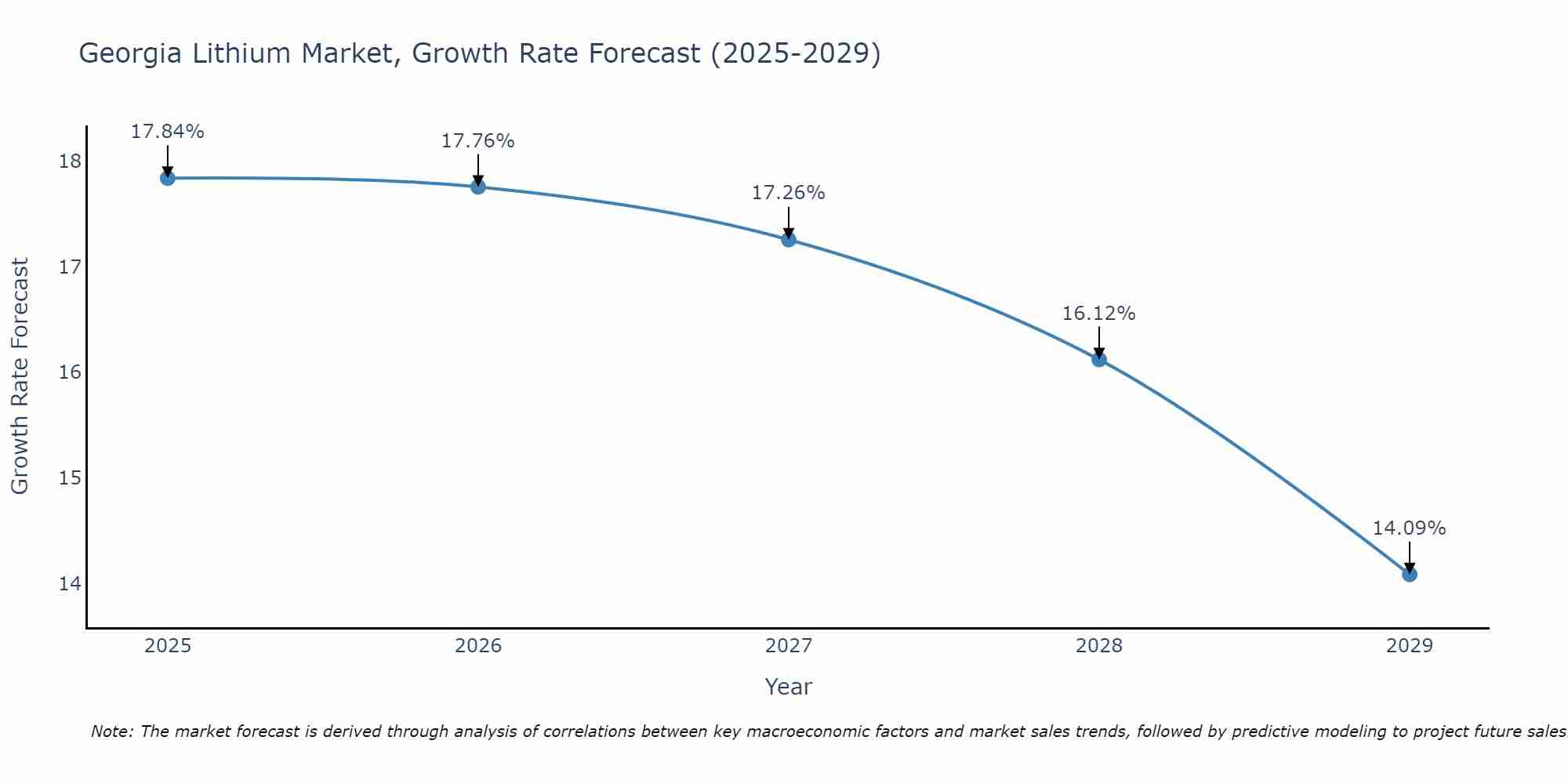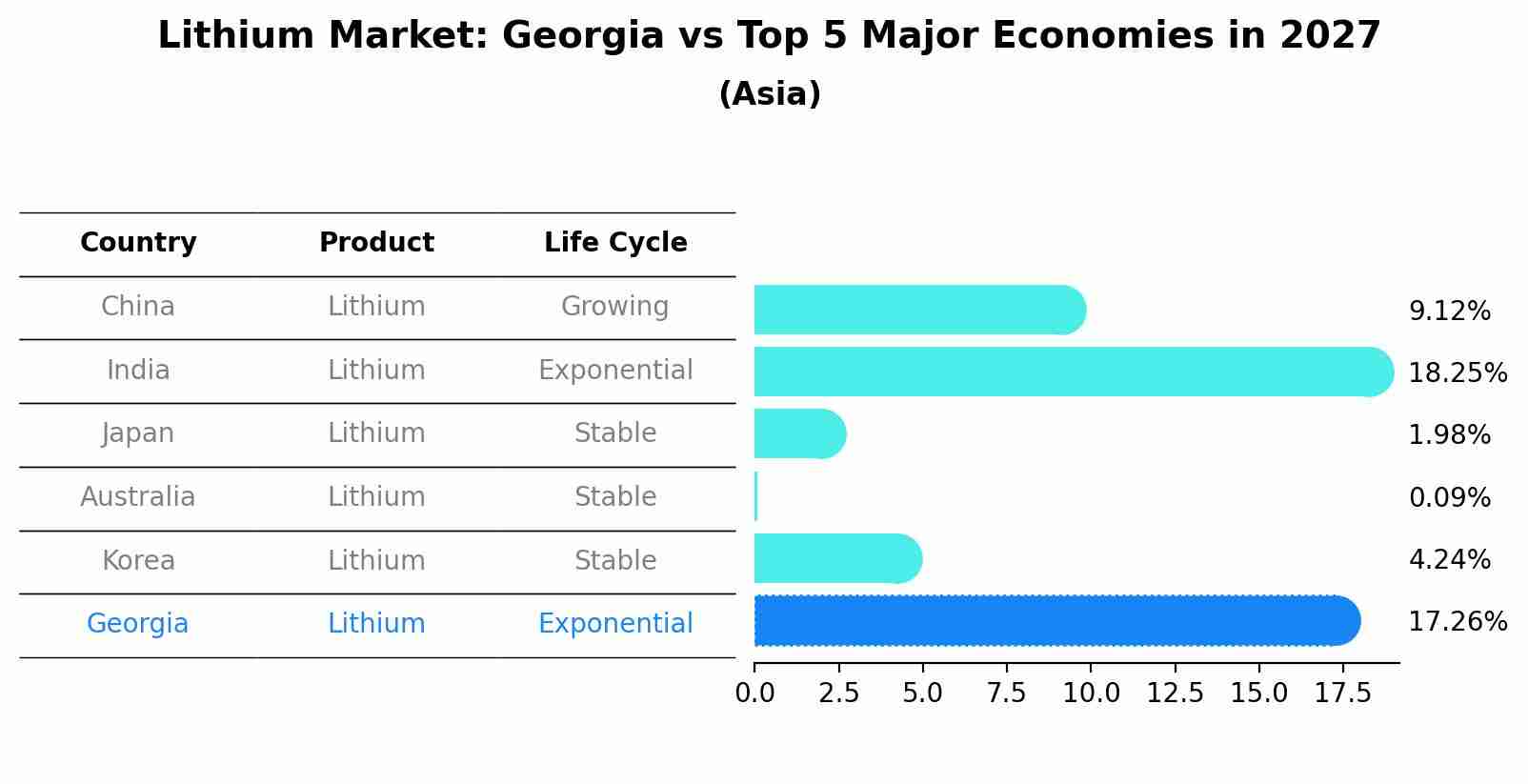Georgia Lithium Market Outlook | Industry, Companies, Size, Share, Value, Forecast, Analysis, Growth, COVID-19 IMPACT, Trends & Revenue
| Product Code: ETC208872 | Publication Date: May 2022 | Updated Date: Aug 2025 | Product Type: Market Research Report | |
| Publisher: 6Wresearch | No. of Pages: 60 | No. of Figures: 40 | No. of Tables: 7 | |
Georgia Lithium Market Size Growth Rate
The Georgia Lithium Market may undergo a gradual slowdown in growth rates between 2025 and 2029. Starting high at 17.84% in 2025, the market steadily declines to 14.09% by 2029.

Lithium Market: Georgia vs Top 5 Major Economies in 2027 (Asia)
The Lithium market in Georgia is projected to grow at a exponential growth rate of 17.26% by 2027, highlighting the country's increasing focus on advanced technologies within the Asia region, where China holds the dominant position, followed closely by India, Japan, Australia and South Korea, shaping overall regional demand.

Georgia Lithium Market Overview
The Georgia Lithium market encompasses the extraction, processing, and export of lithium resources, positioning the state as a significant player in the global lithium supply chain. With increasing demand for lithium-ion batteries in electric vehicles and energy storage systems, Georgia is poised to capitalize on its lithium reserves and attract investment in lithium mining and refining.
Drivers of the market
The Georgia lithium market is experiencing substantial growth driven by the burgeoning demand for lithium-ion batteries in electric vehicles, renewable energy storage, and consumer electronics. Lithium is a key component in the production of lithium-ion batteries, which are essential for the transition towards clean energy and sustainable transportation. Additionally, increasing investments in lithium mining and processing infrastructure, coupled with supportive government policies promoting renewable energy adoption, are fostering market expansion in Georgia.
Challenges of the market
The Georgia lithium market encounters challenges related to global supply chain dynamics, technological innovation, and regulatory uncertainties. As lithium continues to gain prominence as a critical component in various industries, including electronics, automotive, and renewable energy, ensuring a stable and cost-effective supply of raw materials becomes essential for sustaining market growth. However, geopolitical tensions, trade policies, and environmental regulations can introduce volatility and disruptions to the lithium market, impacting both producers and consumers in Georgia.
Government Policy of the market
Georgia government has formulated policies to capitalize on the state`s lithium reserves and promote the development of the lithium market. Recognizing lithium`s strategic importance in various industries, including energy storage, electric vehicles, and electronics, the government has prioritized initiatives to attract investment in lithium exploration, extraction, and processing projects. Incentives such as tax breaks, subsidies, and regulatory support are offered to companies involved in lithium mining, refining, and manufacturing. Furthermore, efforts are made to streamline permitting processes, infrastructure development, and stakeholder engagement to facilitate responsible and sustainable lithium development while mitigating environmental impacts and maximizing economic benefits for local communities.
Key Highlights of the Report:
- Georgia Lithium Market Outlook
- Market Size of Georgia Lithium Market, 2021
- Forecast of Georgia Lithium Market, 2028
- Historical Data and Forecast of Georgia Lithium Revenues & Volume for the Period 2018 - 2028
- Georgia Lithium Market Trend Evolution
- Georgia Lithium Market Drivers and Challenges
- Georgia Lithium Price Trends
- Georgia Lithium Porter's Five Forces
- Georgia Lithium Industry Life Cycle
- Historical Data and Forecast of Georgia Lithium Market Revenues & Volume By Product for the Period 2018 - 2028
- Historical Data and Forecast of Georgia Lithium Market Revenues & Volume By Carbonates for the Period 2018 - 2028
- Historical Data and Forecast of Georgia Lithium Market Revenues & Volume By Hydroxide for the Period 2018 - 2028
- Historical Data and Forecast of Georgia Lithium Market Revenues & Volume By Others for the Period 2018 - 2028
- Historical Data and Forecast of Georgia Lithium Market Revenues & Volume By Application for the Period 2018 - 2028
- Historical Data and Forecast of Georgia Lithium Market Revenues & Volume By Automotive for the Period 2018 - 2028
- Historical Data and Forecast of Georgia Lithium Market Revenues & Volume By Consumer Electronics for the Period 2018 - 2028
- Historical Data and Forecast of Georgia Lithium Market Revenues & Volume By Grid Storage for the Period 2018 - 2028
- Historical Data and Forecast of Georgia Lithium Market Revenues & Volume By Glass & Ceramics for the Period 2018 - 2028
- Historical Data and Forecast of Georgia Lithium Market Revenues & Volume By Others for the Period 2018 - 2028
- Georgia Lithium Import Export Trade Statistics
- Market Opportunity Assessment By Product
- Market Opportunity Assessment By Application
- Georgia Lithium Top Companies Market Share
- Georgia Lithium Competitive Benchmarking By Technical and Operational Parameters
- Georgia Lithium Company Profiles
- Georgia Lithium Key Strategic Recommendations
Frequently Asked Questions About the Market Study (FAQs):
1 Executive Summary |
2 Introduction |
2.1 Key Highlights of the Report |
2.2 Report Description |
2.3 Market Scope & Segmentation |
2.4 Research Methodology |
2.5 Assumptions |
3 Georgia Lithium Market Overview |
3.1 Georgia Country Macro Economic Indicators |
3.2 Georgia Lithium Market Revenues & Volume, 2021 & 2028F |
3.3 Georgia Lithium Market - Industry Life Cycle |
3.4 Georgia Lithium Market - Porter's Five Forces |
3.5 Georgia Lithium Market Revenues & Volume Share, By Product, 2021 & 2028F |
3.6 Georgia Lithium Market Revenues & Volume Share, By Application, 2021 & 2028F |
4 Georgia Lithium Market Dynamics |
4.1 Impact Analysis |
4.2 Market Drivers |
4.2.1 Increasing demand for lithium-ion batteries in electric vehicles and renewable energy storage systems |
4.2.2 Favorable government policies promoting the use of electric vehicles and renewable energy sources |
4.2.3 Growing investments in lithium mining and processing technologies in Georgia |
4.3 Market Restraints |
4.3.1 Fluctuating lithium prices in the global market |
4.3.2 Environmental concerns related to lithium mining and processing activities |
4.3.3 Lack of domestic infrastructure for lithium extraction and processing in Georgia |
5 Georgia Lithium Market Trends |
6 Georgia Lithium Market, By Types |
6.1 Georgia Lithium Market, By Product |
6.1.1 Overview and Analysis |
6.1.2 Georgia Lithium Market Revenues & Volume, By Product, 2018 - 2028F |
6.1.3 Georgia Lithium Market Revenues & Volume, By Carbonates, 2018 - 2028F |
6.1.4 Georgia Lithium Market Revenues & Volume, By Hydroxide, 2018 - 2028F |
6.1.5 Georgia Lithium Market Revenues & Volume, By Others, 2018 - 2028F |
6.2 Georgia Lithium Market, By Application |
6.2.1 Overview and Analysis |
6.2.2 Georgia Lithium Market Revenues & Volume, By Automotive, 2018 - 2028F |
6.2.3 Georgia Lithium Market Revenues & Volume, By Consumer Electronics, 2018 - 2028F |
6.2.4 Georgia Lithium Market Revenues & Volume, By Grid Storage, 2018 - 2028F |
6.2.5 Georgia Lithium Market Revenues & Volume, By Glass & Ceramics, 2018 - 2028F |
6.2.6 Georgia Lithium Market Revenues & Volume, By Others, 2018 - 2028F |
7 Georgia Lithium Market Import-Export Trade Statistics |
7.1 Georgia Lithium Market Export to Major Countries |
7.2 Georgia Lithium Market Imports from Major Countries |
8 Georgia Lithium Market Key Performance Indicators |
8.1 Lithium reserves exploration and discovery rate in Georgia |
8.2 Investment in lithium mining and processing projects |
8.3 Adoption rate of electric vehicles and renewable energy systems in Georgia |
9 Georgia Lithium Market - Opportunity Assessment |
9.1 Georgia Lithium Market Opportunity Assessment, By Product, 2021 & 2028F |
9.2 Georgia Lithium Market Opportunity Assessment, By Application, 2021 & 2028F |
10 Georgia Lithium Market - Competitive Landscape |
10.1 Georgia Lithium Market Revenue Share, By Companies, 2021 |
10.2 Georgia Lithium Market Competitive Benchmarking, By Operating and Technical Parameters |
11 Company Profiles |
12 Recommendations |
13 Disclaimer |
- Single User License$ 1,995
- Department License$ 2,400
- Site License$ 3,120
- Global License$ 3,795
Search
Related Reports
- Portugal Electronic Document Management Market (2025-2031) | Strategy, Consumer Insights, Analysis, Investment Trends, Opportunities, Growth, Size, Share, Industry, Revenue, Segments, Value, Segmentation, Supply, Forecast, Restraints, Outlook, Competition, Drivers, Trends, Demand, Pricing Analysis, Competitive, Strategic Insights, Companies, Challenges
- France Electronic Document Management Market (2025-2031) | Strategy, Consumer Insights, Analysis, Investment Trends, Opportunities, Growth, Size, Share, Industry, Revenue, Segments, Value, Segmentation, Supply, Forecast, Restraints, Outlook, Competition, Drivers, Trends, Demand, Pricing Analysis, Competitive, Strategic Insights, Companies, Challenges
- Portugal Occupational Health & Safety Services Market (2025-2031) | Strategy, Consumer Insights, Analysis, Investment Trends, Opportunities, Growth, Size, Share, Industry, Revenue, Segments, Value, Segmentation, Supply, Forecast, Restraints, Outlook, Competition, Drivers, Trends, Demand, Pricing Analysis, Competitive, Strategic Insights, Companies, Challenges
- Netherlands Occupational Health and Safety Services Market (2025-2031) | Strategy, Consumer Insights, Analysis, Investment Trends, Opportunities, Growth, Size, Share, Industry, Revenue, Segments, Value, Segmentation, Supply, Forecast, Restraints, Outlook, Competition, Drivers, Trends, Demand, Pricing Analysis, Competitive, Strategic Insights, Companies, Challenges
- Belgium and Luxembourg Facility Management Market (2025-2031) | Strategy, Consumer Insights, Analysis, Investment Trends, Opportunities, Growth, Size, Share, Industry, Revenue, Segments, Value, Segmentation, Supply, Forecast, Restraints, Outlook, Competition, Drivers, Trends, Demand, Pricing Analysis, Competitive, Strategic Insights, Companies, Challenges
- Russia Women Intimate Apparel Market (2025-2031) | Strategy, Consumer Insights, Analysis, Investment Trends, Opportunities, Growth, Size, Share, Industry, Revenue, Segments, Value, Segmentation, Supply, Forecast, Restraints, Outlook, Competition, Drivers, Trends, Demand, Pricing Analysis, Competitive, Strategic Insights, Companies, Challenges
- Africa Chocolate Market (2025-2031) | Size, Share, Trends, Growth, Revenue, Analysis, Forecast, industry & Outlook
- Global Hydroxychloroquine And Chloroquine Market (2025-2031) | Industry, Trends, Size, Outlook, Growth, Value, Companies, Revenue, Analysis, Share, Forecast
- Saudi Arabia Plant Maintenance Market (2025-2031) | Industry, Size, Growth, Revenue, Value, Companies, Forecast, Analysis, Share & Trends
- Taiwan Electric Truck Market (2025-2031) | Outlook, Industry, Revenue, Size, Forecast, Growth, Analysis, Share, Companies, Value & Trends
Industry Events and Analyst Meet
Our Clients
Whitepaper
- Middle East & Africa Commercial Security Market Click here to view more.
- Middle East & Africa Fire Safety Systems & Equipment Market Click here to view more.
- GCC Drone Market Click here to view more.
- Middle East Lighting Fixture Market Click here to view more.
- GCC Physical & Perimeter Security Market Click here to view more.
6WResearch In News
- Doha a strategic location for EV manufacturing hub: IPA Qatar
- Demand for luxury TVs surging in the GCC, says Samsung
- Empowering Growth: The Thriving Journey of Bangladesh’s Cable Industry
- Demand for luxury TVs surging in the GCC, says Samsung
- Video call with a traditional healer? Once unthinkable, it’s now common in South Africa
- Intelligent Buildings To Smooth GCC’s Path To Net Zero













